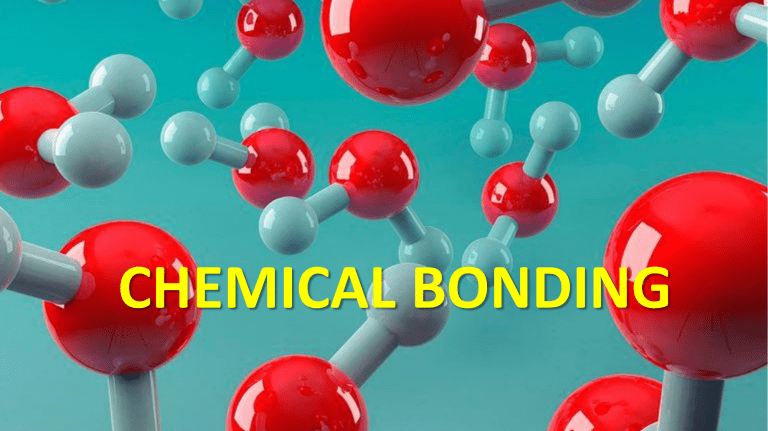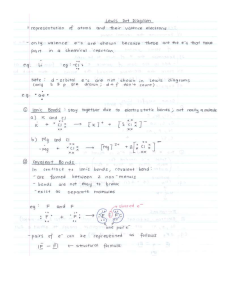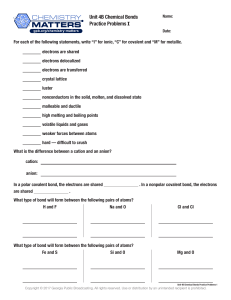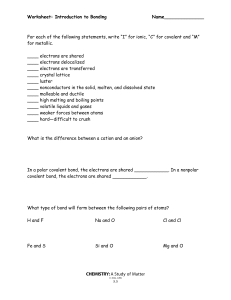
CHEMICAL BONDING Chemical Bonding ― defined as any arrangement of electron in two atoms that generates a force, causing the atoms to be bound to each other, forming a molecule Periodic Groups Group 1A: Alkali Metals Group 2A: Alkaline-Earth Metals Group 3A: Boron Group Group 4A: Carbon Group Group 5A: Nitrogen Group Group 6A: Chalcogens Group 7A: Halogens Group 8A: Noble Gases Valence Electrons ➢ electron in the outermost orbital shell ➢ electron that can be gained or lost ➢ Noble gases, complete valence – most stable Group 8 (NOBLE GASES) ➢ last electron shell completely filled ➢ lowest tendency to gain, lose, or share electrons ➢ they are inert ➢ least likely to react with other elements Octet Rule ➢ all atom must have eight electrons ➢ atoms form bonds to have 8 valence electrons ➢ compounds containing 8 valence electrons are stable ➢ does not apply with hydrogen Lewis Structure ➢ strictly follows the octet rule ➢ illustrations of electrons in an element ➢ dots surrounding elements represents valence electron(s) Chemical Bond ― an attempt to fill electron shells by transfer (losing or gaining) or sharing of electrons to achieve greater stability ― force of attraction that holds atoms together Ionic Bonding ― or elctrovalent bond involves the transfer of electrons from one atom to another, usually between a metal and a non-metal, forming electrically charged atoms of ions ― the strong electrostatic attraction between the cation and the anion hold them together, to form an ionic compound Ionic Bonding Ionic Compounds ➢ hard and brittle ➢ form crystal lattices rather than amorphous solids ➢ have high melting and boiling point ➢ conduct electricity when dissolved in water ➢ good insulators in solid state Covalent Bonding ― formed when two electrons are shared between two or more atoms resulting in the formation of a molecule ― the shared pair of electrons is simultaneously being attracted by the nuclei of the two atoms, thus holding them together ― generally formed between non-metals Covalent Bonding Covalent Bonding Covalency number ― number of covalent bonds that an atom can form within a molecule ― number of unpaired electrons indicates the number of covalent bonds Types of Covalent Bonds Normal Covalent bond ― formed when both atoms donate to form the shared pair Coordinate covalent bonds ― formed when the electrons that constitute the shared electron pair comes from only one of the participating atoms Bond Polarity ➢ bonding between unlike atoms results in unequal sharing of the electrons ➢ one atom pulls the electrons in the bond closer to its side and one end of the bond has larger electron density than the other ➢ the end with the larger electron density gets a partial negative charge and the end that is electron deficient gets a partial positive charge d+ H •• Cl d- Bond Polarity Polar Covalent bond ― results from unequal sharing between two different atoms ― the greater the electronegativity between two atoms joined by a covalent bond, the more polar the bond is Nonpolar covalent bonds ― results from equal sharing of electrons between bonded atoms Bond Polarity Bond Polarity 3.0-3.0 = 0.0 4.0-2.1 = 1.9 Covalent Pure 0 0.4 3.0-0.9 = 2.1 Ionic Polar 2.0 Electronegativity difference 4.0 Covalent Compounds ➢ exist as gases, liquids, or solids, made-up of molecules ➢ tends to be soft and very flexible ➢ low melting points and boiling points ➢ poor electrical conductors ➢ many soluble in nonpolar liquids Diatomic Elements ➢ elements which cannot exist by themselves ➢ combines with atoms of the same element ➢ exists diatomically to be stable Resonance Structure ➢ molecules with two or more Lewis structure ➢ differs only in the position of electrons ➢ only unshared and multiple bonded electrons can be moved Metallic Bond ― formed between atoms of metallic elements ― holds metal ions very strongly ― electron cloud around atoms which accounts for properties such as good conductors at all states, lustrous, very high melting points ― examples; Na, Fe, Al, Au, Co ANY QUESTIONS???




